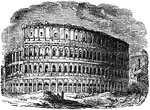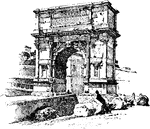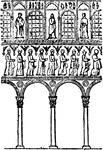This ClipArt gallery offers 249 illustrations of ancient Roman architecture. Roman architecture adopted many styles from the Greek, and is most noted for their expert implementation and frequent use of the arch and dome. See also the Roman Ornament ClipArt gallery.

Abacus
An abacus is denoted primarily a square tablet of any description, and was hence employed in the following…

Acanthus
"A genus of small herbaceous plants of southern Europe and Africa; they have spinosely toothed leaves,…
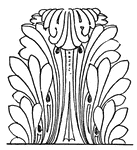
Acanthus Leaves
The Roman acanthus constitutes a type, rather than a particular form of leaf. As compared with the Greek…
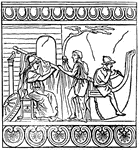
Antefixa
"Antefixa representing Minerva superintending the construction of the Ship Argo. Antefixa are terra-cottas,…
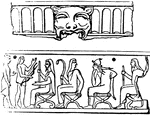
Antefixa
"The two imperfect antefixa, are amoung those found at Velletri, and described by Carloni. Antefixa…

Construction of a Portion of Appian Way
A famous road with many branches which connected Rome with Southern Italy

Aqueduct
"A conduit for conveying water more particularly applied to structures for conveying water from distant…
Roman Aqueduct
"Part of a Roman Aqueduct. Aqueducts form one of the most characteristic features of Roman architecture.…

Roman Arcade with Engaged Columns
An arcade is a passage or walkway covered over by a succession of arches or vaults supported by columns.…
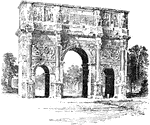
Arch of Constantine
The Arch of Constantine is a triumphal arch in Rome between the Colosseum and the Palatine Hill.
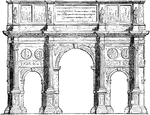
Arch of Constantine
"Triumphal arches from a class apart among the monuments of Roman architecture. It was an early custom…
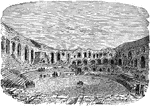
The Amphitheater of Arles
The amphitheater of Arles is a roman amphitheater in the southern French town of Arles. It is still…

Roman Astragal
"Roman Ovolo Molding, with Pearl Beading. The ornamentation had to correspond with the massive character…

Roman Astragal
"Ornamented Roman Astragal. The ornamentation had to correspond with the massive character of Roman…
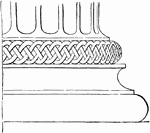
Attic Base in the Temple of Minerva Polias
The so-called Attic base is the form which most frequently occurs; and consists of two tori separated…

Banqueting room
"The Roman people reclined at their meals. On each couch there were commonly three persons. They lay…

Basilica
"Section of the Basilica of Constantine or Maxentius (Temple of Peace)." — Encyclopedia Britanica,…
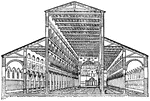
Basilica
"Sectional view of the old Basilica of St. Peter, before its destruction in the 15th century." —…

Basilica
"Interior view of trajan's Basilica (Basilica Ulpia), as restored by Canina." — The Encyclopedia…

Basilica
"Section of the Basilica of Maxentius or Constantine (Temple of Peace)." — The Encyclopedia Britannica,…

Basilica
"Sectional view of the old Basilica of St. Peter, before its destruction in the 16th century." —…

Basilica
"A building which served as a court of law and an exchange, or place of meeting for merchants and men…

Basilica of Constantine
"Section of the Basilica of Maxentius or Constantine (Temple of Peace)." — Encyclopediia Britannica,…

Basilica of Maxentius
"The Basilica of Maxentius has great intersecting vaults, vaulted aisles and buttresses." — Chambers,…

Basilica of Old St Peter
"Sectional view of the old Basilica of St. Peter, before its destruction in the 16th century." —…
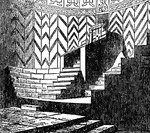
Apse of the Basilica
"Apse of the Basilica, Torcello, with Bishop's throne and seats for the clergy."

Bead
A roman moulding, called a Bead. It is a molding consisting of a semi-circle on a flat surface.…
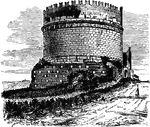
Tomb of Cæcilia Metella
"The usual form of independent monumental tombs was a ponderous tower-shaped block, sometimes square,…

Caesar's Bridge Over the Rhine
A bridge built by Julius Caesar and his legionaries to aid in crossing the Rhine River. They are considered…
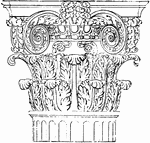
Composite capital
"The Composite or Roman order was the outcome of the attempt to improve the Corinthian, of which it…
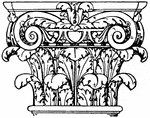
Roman Composite Capital
The Roman composite capital is a fusion of the ionic and corinthian capitals.

Roman Corinthian Capital
The Roman Corinthian capital is found in the palaces of the emperors in Rome. It is a design of spiral…
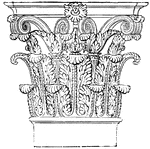
Roman-Corinthian Capital
"The favorite order was the richly-decorated Corinthian, the beauty of which the Romans strove to increase…
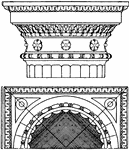
Roman-Doric Capital
The Roman-Doric capital is an antique design. It is found on the upper termination of a column.

Roman-Ionic Capital
The Roman-ionic capital is a design of a scroll rolled on both sides with spiral curves. It has an added…

Capitoline Hill in Rome
The Capitoline Hill, between the Forum and the Campus Martius, is one of the seven hills of Rome. By…



